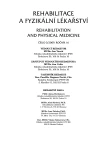Possible Compensation of Constitutive Hypermobility by Exercise in the Fitness Center
Authors:
D. Stackeová; K. Blažková
Authors‘ workplace:
Katedra fyzioterapie FTVS UK Praha
vedoucí katedry doc. PaedDr. D. Pavlů, CSc.
Published in:
Rehabil. fyz. Lék., 16, 2009, No. 3, pp. 120-125.
Category:
Original Papers
Overview
This article deals with the problem of the constitutional hypermobility and its compensation possibilities. The first part includes the theoretical information about hypermobility and its diagnostic and you can find information about possibilities of its compensation using fitness exercises in the second part. We mean specific method applied by erudite specialist. On the opposite side, practicing exercises of “traditional” strength training is contraindicated by these patients.
Key words:
hypermobility, hypermobility syndrome, physiotherapy, fitness centre
Sources
1. BEIGHTON, P., SOLOMON, L., SOSKOLNE, C. L.: Articular mobility in an African population. Ann. Rheum. Dis., 32, 1973, s. 413-418.
2. BULBENA, A., DURO, J. C., PORTA, M. et al.: Clinical assessment of hypermobility of joints: assembling criteria. Rheumatol., 19, 1992, s. 115-122.
3. CARTER, C., WILKINSON, J.: Persistent joint laxity and congenital dislocation of the hip. Bone Joint Surg. Br.,46, 1964, s. 40-45.
4. FINSTERBUSH, A, POGRUND, H.: The hypermobility syndrome. Musculoskeletal complaints in 100 consecutive cases of generalized joint hypermobility. Clin Orthop, 1982, s. 124.
5. GRAHAME, R, BIRD, H. A., CHILD, A.: The revised (Brighton, 1998) criteria for the diagnosis of benign joint hypermobility syndrome (BJHS). J. Rheumatol., 27, 2000, s. 1777.
6. HAMMER, W.: Hypermobility syndrome. Dynamic Chiropractic, 18, 2000, 14 [online].[cit.2009-05-10] dostupné z: http://www.chiroweb.com/mpacms/dc/article.php?id=31763.
7. JANDA, V. a kol.: Svalové funkční testy. Praha, Grada, 2004. ISBN 80-247-0722-5.
8. JANDA, V.: Hypermobilita. [online].[cit. 2009-05-10] dostupné z: http://www.cls.cz/seznam-doporucenych-postupu.
9. JANDA, V.: Manuelle muskelfunktionsdiagnostik. München, Jena, Urban und Fischer, 2000. ISBN 3-437-46430-2.
10. JESSEE, E. F., OWEN, D. J. Jr, SAGAR, K. B.: The benign hypermobile joint syndrome. Arthritis Rheum, 23, 1980, s. 1053.
11. JUUL-KRISTENSEN, B., ROGIND, H. et al.: Inter-examiner reproducibility of tests and criteria for generalized joint hypermobility and benign joint hypermobility syndrome. Rheumatology, 46, 2007, s. 18351841. [online].[cit.2009-05-10] dostupné z: http://rheumatology.oxfordjournals.org/cgi/content/full/46/12/1835.
12. KIRK, J. A., ANSELL, B. M., BYWATERS, E. G.: The hypermobility syndrome. Musculoskeletal complaints associated with generalized joint hypermobility. Ann. Rheum. Dis., 26, 1967, s. 419-425.
13. RUSSEK, L. N.: Examination and treatment of a patient with hypermobility syndrome. Physical Therapy, 80, 2000, 4, s. 386-398.
14. SACHSE, J.: Manuelle Untersuchung. Berlin, Ullstein Mosby, 1993.
15. SHEON, R.: Clinical manifestations and treatment of the hypermobility syndrome. [online].[cit.2009-05-10]. Dostupné z: (poslední revize 2. 5. 2008).
16. SHEON, R. P., KIRSNER, A. B., FARBER, S. J., FINKEL, R. I.: The hypermobility syndrome. Postgrad Med., 71, 1982, s. 199.
17. SHIEL, W. C.: Hypermobility Syndrome. [online].[cit.2009-05-10] dostupné z: http://www.medicinenet.com/hypermobility_syndrome/article.htm. (poslední revize 26. 9. 2007).
18. SIMMONDS, J.: Living with HMS: Keeping fit! [online].[cit.2009-05-10] dostupné z: http://www.hypermobility.org/fitness.php
19. STACKEOVÁ, D.: Fitness programy – teorie a praxe : metodika cvičení ve fitness centrech. 2. doplněné a přepracované vydání (1. vydání ve vydavatelství Galén). Praha, Galén, 2008. ISBN 978-80-7262-541-3.
20. TLAPÁK, P.: Tvarování těla. Praha, ARSCI, 2007. 6. vyd., ISBN 978-80-86078-72-4.
21. VÉLE, F.: Kineziologie. Praha, Triton, 2006. 2. vyd., ISBN 80-7254-837-9.
Labels
Physiotherapist, university degree Rehabilitation Sports medicineArticle was published in
Rehabilitation & Physical Medicine

2009 Issue 3
- Hope Awakens with Early Diagnosis of Parkinson's Disease Based on Skin Odor
- Deep stimulation of the globus pallidus improved clinical symptoms in a patient with refractory parkinsonism and genetic mutation
Most read in this issue
- Postural Strategy in the Course of Motor Development
- The Problem of Postoperative Stump in Patients with Transtibial Amputation as Viewed by Physiotherapist, Biomechanic and Prosthetic Specialists
- Possible Compensation of Constitutive Hypermobility by Exercise in the Fitness Center
- Therapeutic Solution of Lateral Instability of Astragalus Ligaments
